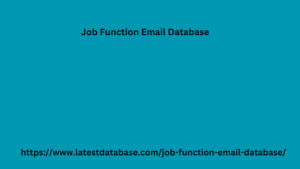In the competitive landscape of business-to-business (B2B) marketing, data targeting has emerged as a crucial strategy for companies seeking to optimize their outreach and maximize their return on investment (ROI). By leveraging accurate, detailed data about potential clients, B2B companies can create targeted marketing campaigns that resonate with their audience. This comprehensive guide explores the intricacies of B2B data targeting, its importance, methodologies, top strategies, and best practices to help businesses achieve their marketing goals.
Table of Contents
- Understanding B2B Data Targeting
- 1.1 Definition of B2B Data Targeting
- 1.2 The Importance of Data in B2B Marketing
- Types of B2B Data for Targeting
- 2.1 Firmographic Data
- 2.2 Demographic Data
- 2.3 Technographic Data
- 2.4 Intent Data
- The Benefits of Effective B2B Data Targeting
- 3.1 Improved Lead Quality
- 3.2 Enhanced Marketing ROI
- 3.3 Increased Customer Engagement
- Strategies for Effective B2B Data Targeting
- 4.1 Segmentation Techniques
- 4.2 Personalization of Campaigns
- 4.3 Multi-Channel Targeting
- Best Practices for B2B Data Targeting
- 5.1 Regular Data Cleaning and Maintenance
- 5.2 Utilizing Data Analytics
- 5.3 Compliance and Ethical Considerations
1. Understanding B2B Data Targeting
1.1 Definition of B2B Data Targeting
B2B data targeting involves using detailed information about businesses to identify and reach potential customers more effectively. This process entails analyzing various data points to segment and target specific groups within the broader market, ensuring that marketing and sales efforts are directed towards the most promising prospects.
1.2 The Importance of Data in B2B Marketing
Data is the backbone of effective B2B marketing. With the right data, businesses can:
- Identify Ideal Customers: Data enables companies to pinpoint who their ideal customers are based on characteristics such as industry, size, and behavior.
- Make Informed Decisions: Accurate data helps businesses strategize and make decisions backed by evidence rather than assumptions.
- Optimize Resources: By targeting the right audience, companies can allocate resources more efficiently, reducing waste and increasing productivity.
2. Types of B2B Data for Targeting
2.1 Firmographic Data
Firmographic data includes information about the characteristics of businesses, such as:
- Industry: The sector in which the company operates (e.g., healthcare, technology).
- Company Size: Typically measured by employee count or revenue.
- Location: Geographic information that can influence market dynamics.
This data helps businesses identify potential clients that fit their target market profile.
2.2 Demographic Data
While primarily associated with B2C marketing, demographic data can also be relevant in B2B contexts, particularly when targeting decision-makers. This includes:
- Job Titles: Understanding the roles of individuals within a company (e.g., CEO, Marketing Director).
- Age and Gender: Knowing the demographics of Job Function Email Database decision-makers can inform messaging and content strategies.
2.3 Technographic Data
Technographic data focuses on the technology stack used by potential customers. This includes:
- Software and Tools: Information about the applications and platforms businesses use.
- Technology Adoption: Insights into whether a company is an early adopter or a laggard in technology trends.
Understanding the technology landscape helps tailor solutions that meet specific needs.
2.4 Intent Data
Intent data indicates a potential customer’s interest in specific products or services based on their online behavior. This includes:
- Website Visits: Pages visited and time spent on a site.
- Content Consumption: Articles read, videos watched, or whitepapers downloaded.
By analyzing intent data, businesses can prioritize leads that are actively researching solutions.
3. The Benefits of Effective B2B Data Targeting
3.1 Improved Lead Quality
Effective data targeting results in higher-quality leads. By focusing on businesses that match specific criteria, companies can engage prospects more likely to convert into customers.
3.2 Enhanced Marketing ROI
Data-driven targeting allows businesses to Special Number Data allocate resources efficiently, leading to better campaign performance and a higher return on marketing investments. By reaching the right audience with the right message, companies can reduce acquisition costs.
3.3 Increased Customer Engagement
When marketing messages are tailored to the needs and interests of the target audience, engagement rates soar. Personalized content resonates more with potential customers, fostering a stronger connection and increasing the likelihood of conversion.
4. Strategies for Effective B2B Data Targeting
4.1 Segmentation Techniques
Segmentation is the process of dividing a broader audience into smaller, more manageable groups based on shared characteristics. Effective segmentation strategies include:
- Behavioral Segmentation: Grouping prospects based on their actions and interactions with your brand.
- Needs-Based Segmentation: Identifying specific pain points or needs within different segments.
4.2 Personalization of Campaigns
Personalization involves tailoring marketing messages to individual recipients or specific segments. This can be achieved through:
- Dynamic Content: Using data to create customized email campaigns that reflect the recipient’s interests.
- Targeted Offers: Providing promotions or solutions that address the unique challenges faced by different segments.
Conclusion
B2B data targeting is an essential strategy for businesses looking to enhance their marketing efforts and drive growth. By leveraging various types of data, companies can identify their ideal customers, create personalized marketing campaigns, and ultimately increase their ROI. Implementing effective segmentation, personalization, and multi-channel strategies will empower businesses to engage with prospects meaningfully.
As the B2B landscape continues to evolve, staying informed about best practices and emerging trends in data targeting will ensure that your marketing efforts remain effective and relevant. By prioritizing data quality and compliance, businesses can navigate the complexities of B2B marketing with confidence, unlocking new opportunities for success.


